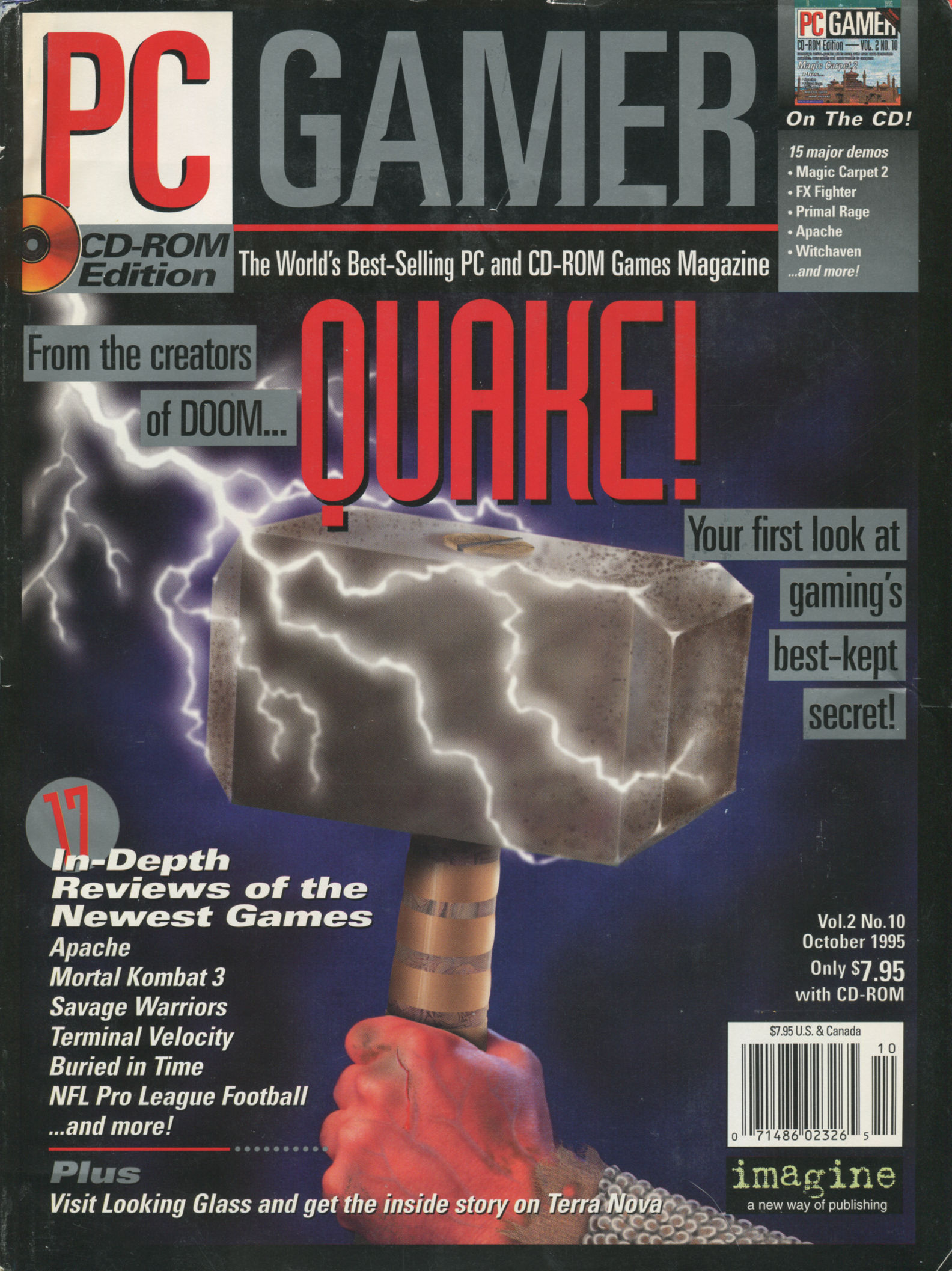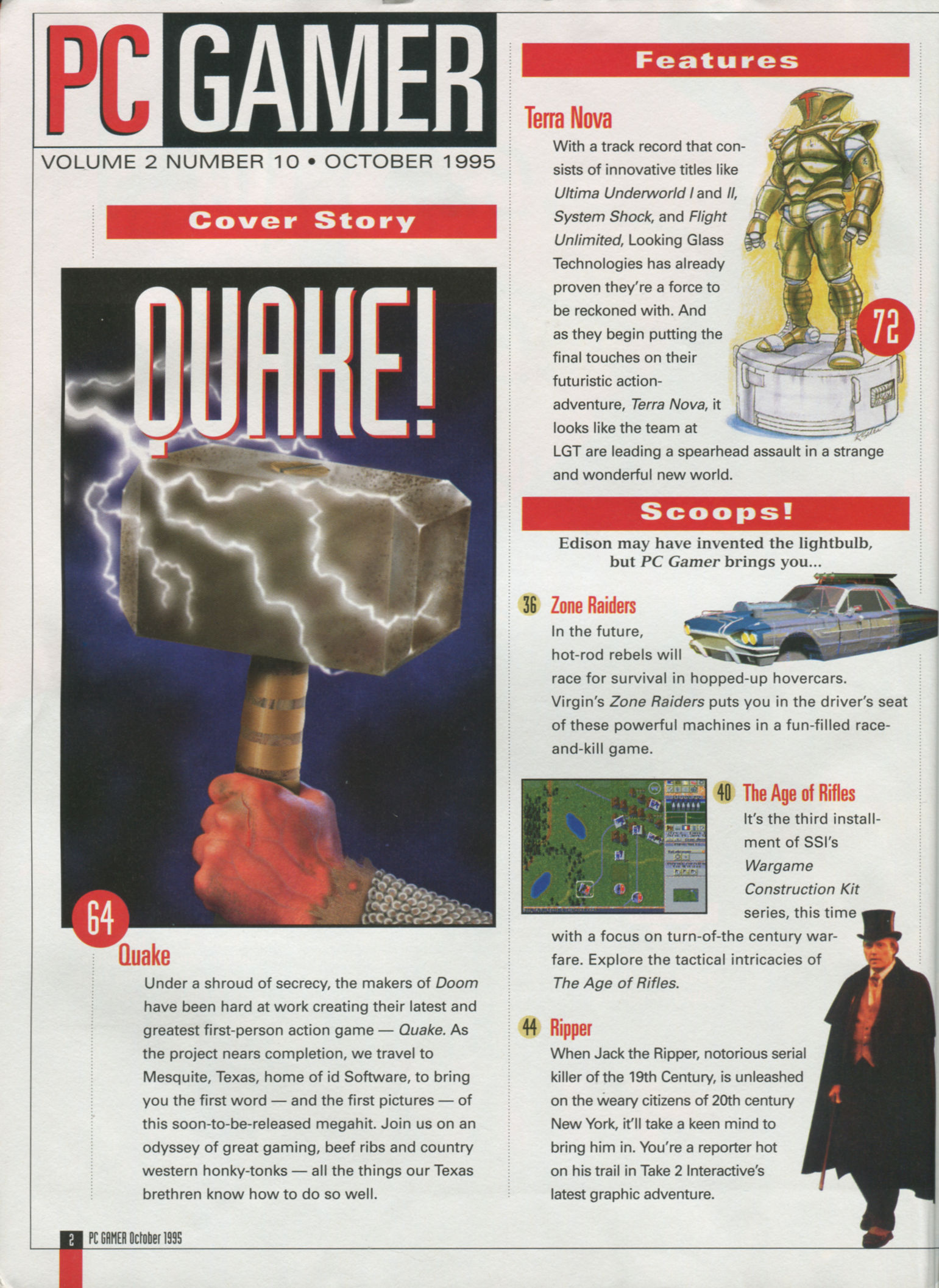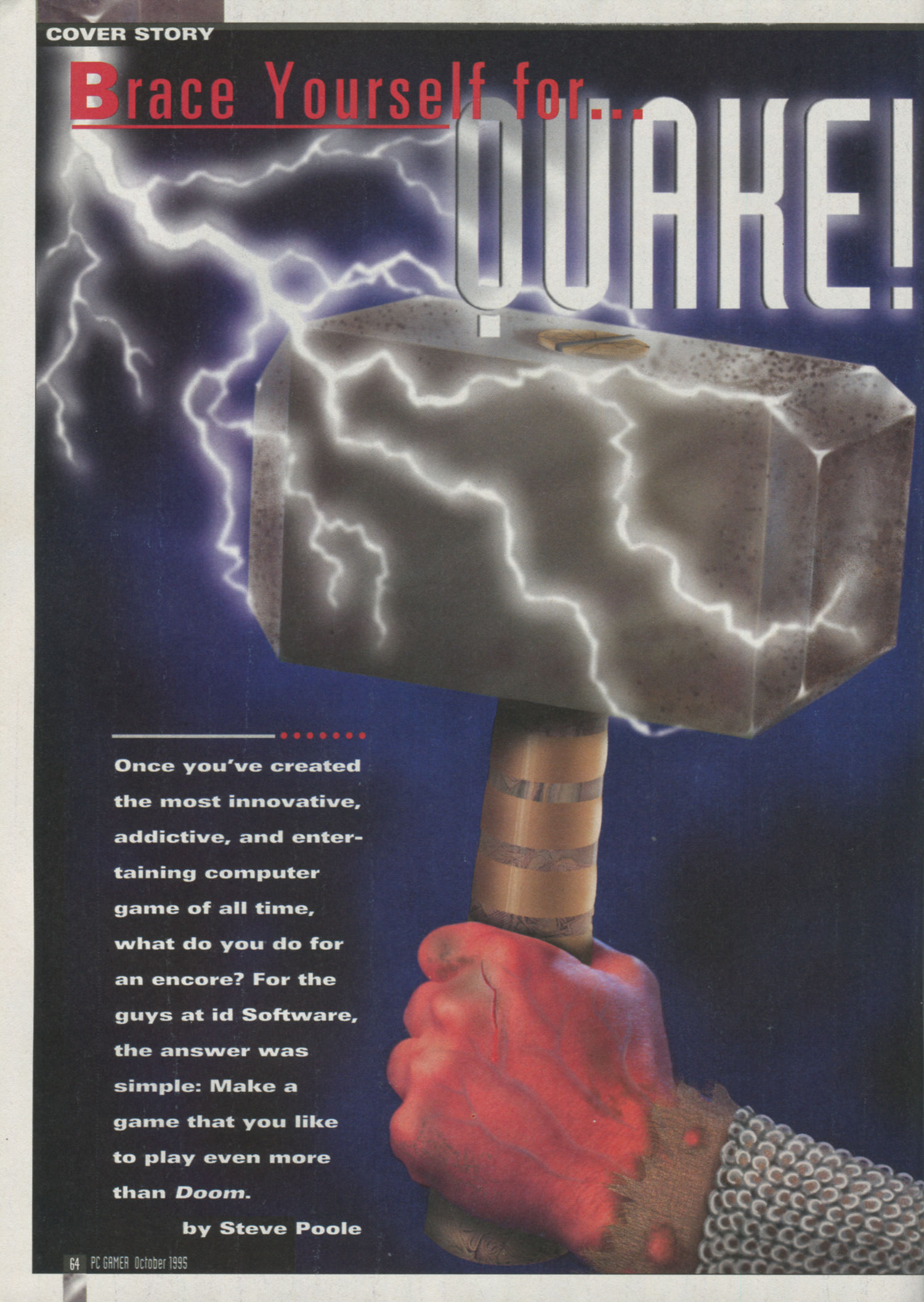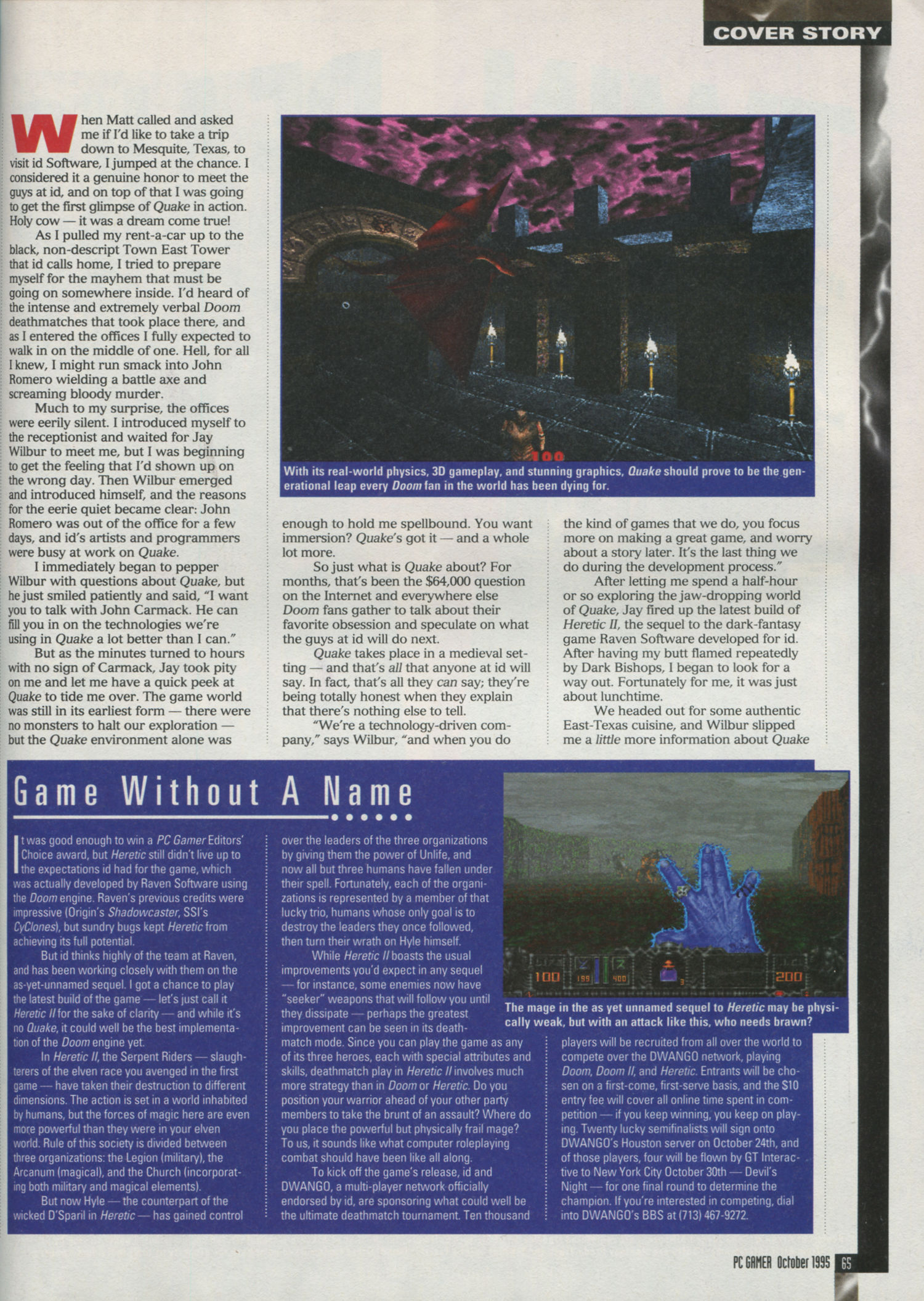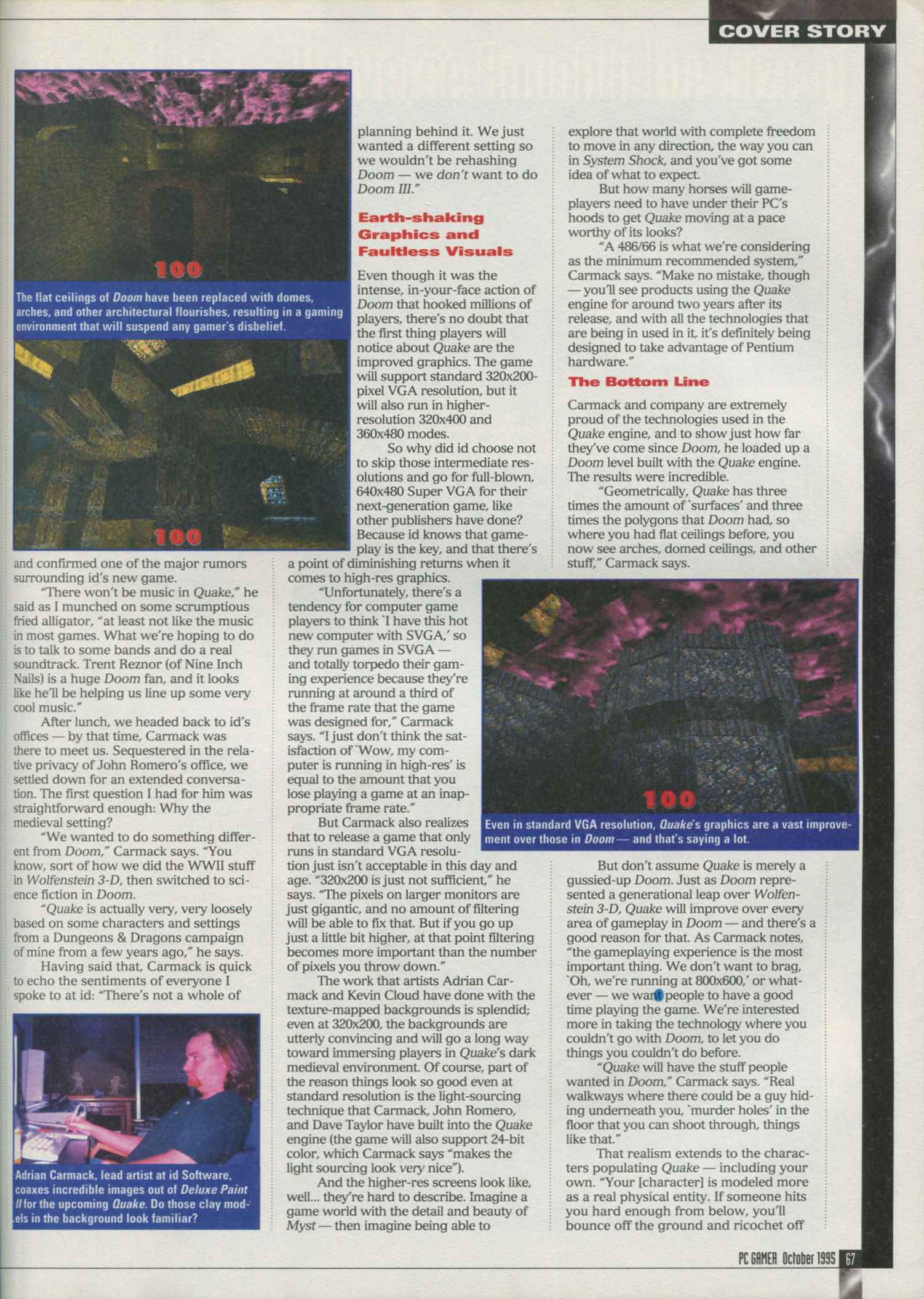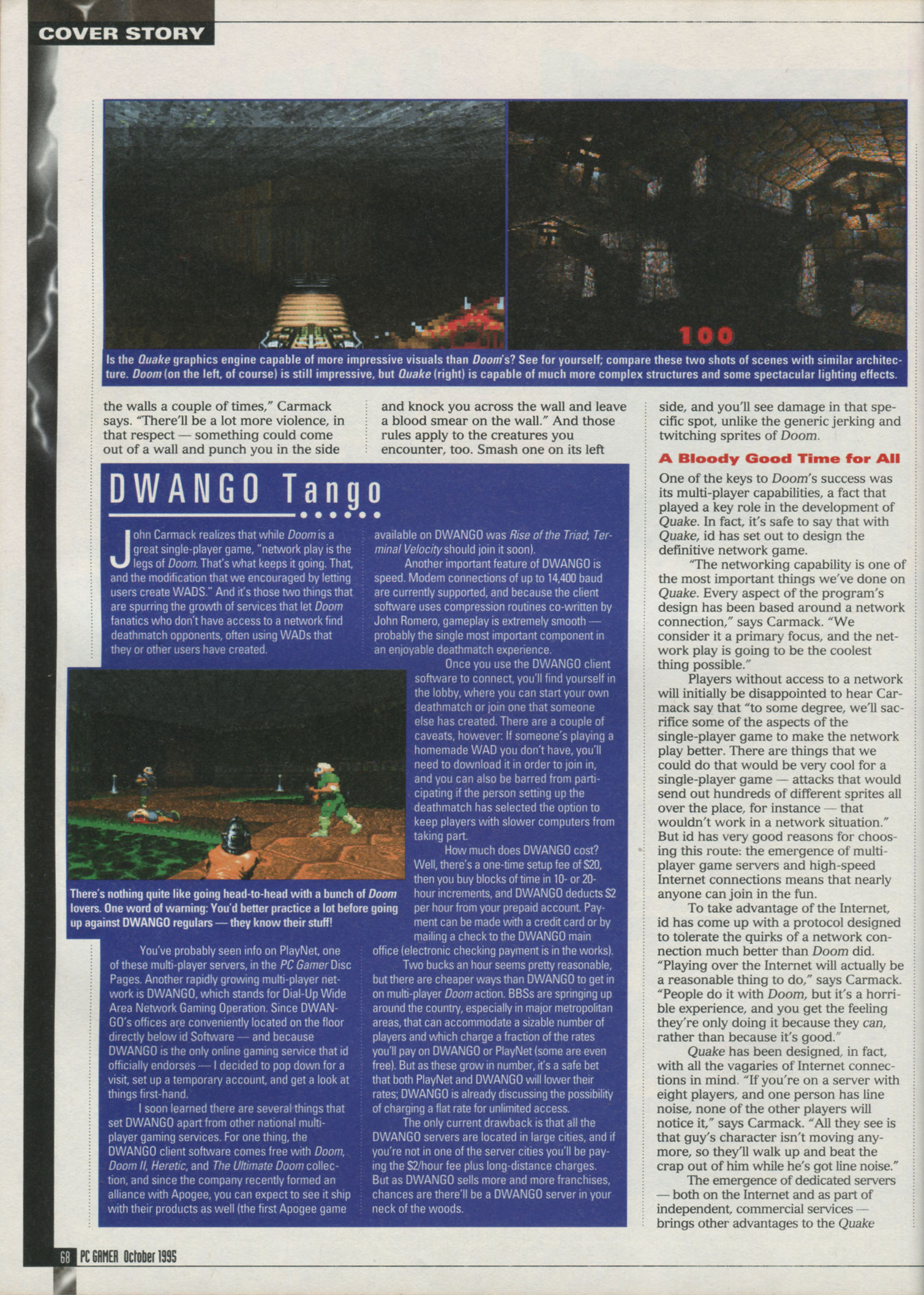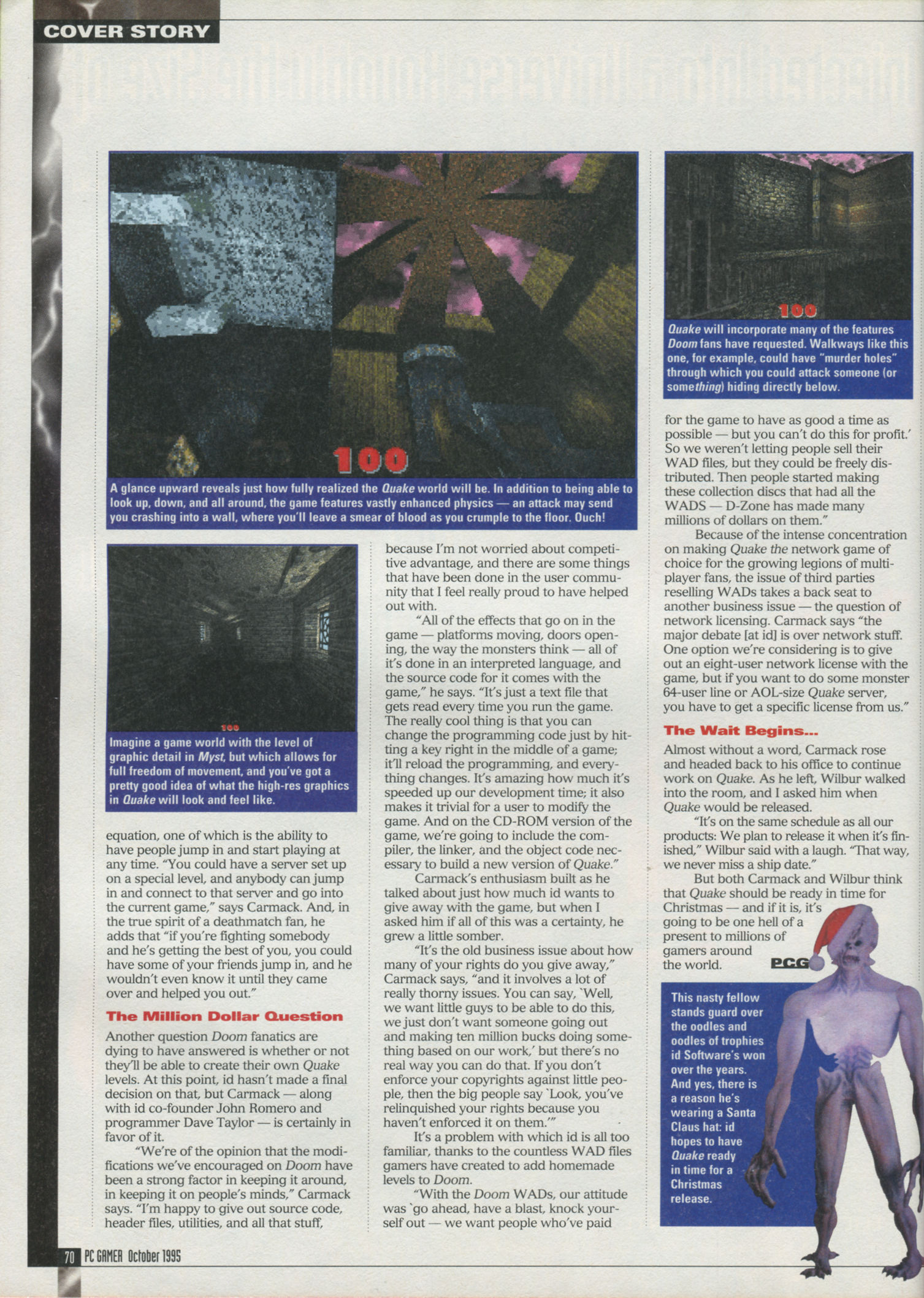PC Gamer Vol. 2 No. 10 October 1995 (US)
Scans
Transcriptions
Cover
From the creators of DOOM… QUAKE! Your first look at gaming's best-kept secret!
Table of contents
Under a shroud of secrecy, the makers of Doom have been hard at work creating their latest and greatest first-person action game – Quake. As the project nears completion, we travel to Mesquite, Texas, home of id Software, to bring you the first word – and the first pictures – of this soon-to-be-released megahit. Join us on an odyssey of great gaming, beef ribs and country western honky-tonks – all the things our Texas brethren know how to do so well.
Quake
Once you've created the most innovative, addictive, and entertaining computer game of all time, what do you do for an encore? For the guys at id Software, the answer was simple: Make a game that you like to play even more than Doom. by Steve Poole
When Matt called and asked me if I'd like to take a trip down to Mesquite, Texas, to visit id Software, I jumped at the chance. I considered it a genuine honor to meet the guys at id, and on top of that I was going to get the first glimpse of Quake in action. Holy cow – it was a dream come true!
As I pulled my rent-a-car up to the black, non-descript Town East Tower that id calls home, I tried to prepare myself for the mayhem that must be going on somewhere inside. I'd heard of the intense and extremely verbal Doom deathmatches that took place there, and as I entered the offices I fully expected to walk in on the middle of one. Hell, for all I knew, I might run smack into John Romero wielding a battle axe and screaming bloody murder.
Much to my surprise, the offices were eerily silent. I introduced myself to the receptionist and waited for Jay Wilbur to meet me, but I was beginning to get the feeling that I'd shown up on the wrong day. Then Wilbur emerged and introduced himself, and the reasons for the eerie quiet became clear: John Romero was out of the office for a few days, and id's artists and programmers were busy at work on Quake.
I immediately began to pepper Wilbur with questions about Quake, but he just smiled patiently and said, "I want you to talk with John Carmack. He can fill you in on the technologies we're using in Quake a lot better than I can."
But as the minutes turned to hours with no sign of Carmack, Jay took pity on me and let me have a quick peek at Quake to tide me over. The game world was still in its earliest form – there were no monsters to halt our exploration – but the Quake environment alone was enough to hold me spellbound. You want immersion? Quake's got it – and a whole lot more.
So just what is Quake about? For months, that's been the $64,000 question on the Internet and everywhere else Doom fans gather to talk about their favorite obsession and speculate on what the guys at id will do next.
Quake takes place in a medieval setting – and that's all that anyone at id will say. In fact, that's all they can say; they're being totally honest when they explain that there's nothing else to tell.
"We're a technology-driven company," says Wilbur, "and when you do the kind of games that we do, you focus more on making a great game, and worry about a story later. It's the last thing we do during the development process."
After letting me spend a half-hour or so exploring the jaw-dropping world of Quake, Jay fired up the latest build of Heretic II, the sequel to the dark-fantasy game Raven Software developed for id. After having my butt flamed repeteadly by Dark Bishops, I began to look for a way out. Fortunately for me, it was just about lunchtime.
We headed out for some authentic East-Texas cuisine, and Wilbur slipped me a little more information about Quake and confirmed one of the major rumors surrounding id's new game.
"There won't be music in Quake," he said as I munched on some scrumptious fried alligator, "at least not like the music in most games. What we're hoping to do is to talk to some bands and do a real soundtrack. Trent Reznor (of Nine Inch Nails) is a huge Doom fan, and it looks like he'll be helping us line up some very cool music."
After lunch, we headed back to id's offices – by that time, Carmack was there to meet us. Sequestered in the relative privacy of John Romero's office, we settled down for an extended conversation. The first question I had for him was straightforward enough: Why the medieval setting?
"We wanted to do something different from Doom," Carmack says. "You know, sort of how we did the WWII stuff in Wolfenstein 3-D, then switched to science fiction in Doom.
"Quake is actually very, very loosely based on some characters and settings from a Dungeons & Dragons campaign of mine from a few years ago," he says.
Having said that, Carmack is quick to echo the sentiments of everyone I spoke to at id: "There's not a whole of planning behind it. We just wanted a different setting so we wouldn't be rehashing Doom – we don't want to do Doom III."
Earth-shaking Graphics and Faultless Visuals
Even though it was the intense, in-your-face action of Doom that hooked millions of players, there's no doubt that the first thing players will notice about Quake are the improved graphics. The game will support standard 320x200-pixel VGA resolution, but it will also run in higher-resolution 320x400 and 360x480 modes.
So why did id choose not to skip those intermediate resolutions and go for full-blown, 640x480 Super VGA for their next-generation game, like other publishers have done? Because id knows that gameplay is the key, and that there's a point of diminishing returns when it comes to high-res graphics.
"Unfortunately, there's a tendency for computer game players to think 'I have this hot new computer with SVGA,' so they run games in SVGA – and totally torpedo their gaming experience because they're running at around a third of the frame rate that the game was designed for," Carmack says. "I just don't think the satisfaction of 'Wow, my computer is running in high-res' is equal to the amount that you lose playing a game at an inappropriate frame rate."
But Carmack also realizes that to release a game that only runs in standard VGA resolution just isn't acceptable in this day and age. "320x200 is just not sufficient," he says. "The pixels on larger monitors are just gigantic, and no amount of filtering will be able to fix that. But if you go up just a little bit higher, at that point filtering becomes more important than the number of pixels you throw down."
The work that artists Adrian Carmack and Kevin Cloud have done with the texture-mapped backgrounds is splendid; even at 320x200, the backgrounds are utterly convincing and will go a long way toward immersing players in Quake's dark medieval environment. Of course, part of the reason things look so good even at standard resolution is the light-sourcing technique that Carmack, John Romero, and Dave Taylor have built into the Quake engine (the game will also support 24-bit color, which Carmack says "makes the light sourcing look very nice").
And the higher-res screens look like, well… they're hard to describe. Imagine a game world with the detail and beauty of Myst – then imagine being able to explore that world with complete freedom to move in any direction, the way you can in System Shock, and you've got some idea of what to expect.
But how many horses will gameplayers need to have unders their PC's hoods to get Quake moving at a pace worthy of its looks?
"A 486/66 is what we're considering as the minimum recommended system," Carmack says. "Make no mistake, though – you'll see products using the Quake engine for around two years after its release, and with all the technologies that are being used in it, it's definitely being designed to take advantage of Pentium hardware."
The Bottom Line
Carmack and company are extremely proud of the technologies used in the Quake engine, and to show just how far they've come since Doom, he loaded up a Doom level built with the Quake engine. The results were incredible.
"Geometrically, Quake has three times the amount of 'surfaces' and three times the polygons that Doom had, so where you had flat ceilings before, you now see arches, domed ceilings, and other stuff," Carmack says.
But don't assume Quake is merely a gussied-up Doom. Just as Doom represented a generational leap over Wolfenstein 3-D, Quake will improve over every area of gameplay in Doom – and there's a good reason for that. As Carmack notes, "the gameplaying experience is the most important thing. We don't want to brag, 'Oh, we're running at 800x600,' or whatever – we want people to have a good time playing the game. We're interested more in taking the technology where you couldn't go with Doom, to let you do things you couldn't do before.
"Quake will have the stuff people wanted in Doom," Carmack says. "Real walkways where there could be a guy hiding underneath you, 'murder holes' in the floor that you can shoot through, things like that."
That realism extends to the characters populating Quake – including your own. "Your [character] is modeled more as a real physical entity. If someone hits you hard enough from below, you'll bounce off the ground and ricochet off the walls a couple of times," Carmack says. "There'll be a lot more violence, in that respect – something could come out of a wall and punch you in the side and knock you across the wall and leave a blood smear on the wall." And those rules apply to the creatures you encounter, too. Smash one on its left side, and you'll see damage in that specific spot, unlike the generic jerking and twitching sprites of Doom.
A Bloody Good Time for All
One of the keys to Doom's success was its multi-player capabilities, a fact that played a key role in the development of Quake. In fact, it's safe to say that with Quake, id has set out to design the definitive network game.
"The networking capability is one of the most important things we've done on Quake. Every aspect of the program's design has been based around a network connection," says Carmack. "We consider it a primary focus, and the network play is going to be the coolest thing possible."
Players without access to a network will initially be disappointed to hear Carmack say that "to some degree, we'll sacrifice some of the aspects of the single-player game to make the network play better. There are things that we could do that would be very cool for a single-player game – attacks that would send out hundreds of different sprites all over the place, for instance – that wouldn't work in a network situation." But id has very good reasons for choosing this route: the emergence of multiplayer game servers and high-speed Internet connections means that nearly anyone can join in the fun.
To take advantage of the Internet, id has come up with a protocol designed to tolerate the quirks of a network connection much better than Doom did. "Playing over the Internet will actually be a reasonable thing to do," says Carmack. "People do it with Doom, but it's a horrible experience, and you get the feeling they're only doing it because they can, rather than because it's good."
Quake has been designed, in fact, with all the vagaries of Internet connections in mind. "If you're on a server with eight players, and one person has line noise, none of the other players will notice it," says Carmack. "All they see is that guy's character isn't moving anymore, so they'll walk up and beat the crap out of him while he's god line noise."
The emergence of dedicated servers – both on the Internet and as a part of independent, commercial services – brings other advantages to the Quake equation, one of which is the hability to have people jump in and start playing at any time. "You could have a server set up on a special level, and anybody can jump in and connect to that server and go into the current game," says Carmack. And, in the true spirit of a deathmatch fan, he adds that "if you're fighting somebody and he's getting the best of you, you could have some of your friends jump in, and he wouldn't even know it until they came over and helped you out."
The Million Dollar Question
Another question Doom fanatics are dying to have answered is whether or not they'll be able to create their own Quake levels. At this point, id hasn't made a final decision on that, but Carmack – along with id co-founder John Romero and programmer Dave Taylor – is certainly in favor of it.
"We're of the opinion that the modifications we've encouraged on Doom have been a strong factor in keeping it around, in keeping it on people's minds," Carmack says. "I'm happy to give out source code, header files, utilities, and all that stuff, because I'm not worried about competitive advantage, and there are some things that have been done in the user community that I feel really proud to have helped out with.
"All of the effects that go on in the game – platforms moving, doors opening, the way the monsters think – all of it's done in an interpreted language, and the source code for it comes with the game," he says. "It's just a text file that gets read every time you run the game. The really cool thing is that you can change the programming code just by hitting a key right in the middle of a game; it'll reload the programming, and everything changes. It's amazing how much it's speeded up our development time; it also makes it trivial for a user to modify the game. And on the CD-ROM version of the game, we're going to include the compiler, the linker, and the object code necessary to build a new version of Quake."
Carmack's enthusiasm built as he talked about just how much id wants to give away with the game, but when I asked him if all of this was a certainty, he grew a little somber.
"It's the old business issue about how many of your rights do you give away," Carmack says, "and it involves a lot of really thorny issues. You can say, 'Well, we want little guys to be able to do this, we just don't want someone going out and making ten million bucks doing something based on our work,' but there's no real way you can do that. If you don't enforce your copyrights against little people, then the big people say 'Look, you've relinquished your rights because you haven't enforced it on them.'"
It's a problem with which id is all too familiar, thanks to the countless WAD files gamers have created to add homemade levels to Doom.
"With the Doom WADs, our attitude was 'go ahead, have a blast, knock yourself out – we want people who've paid for the game to have as good a time as possible – but you can't do this for profit.' So we weren't letting people sell their WAD files, but they could be freely distributed. Then people started making these collection discs that had all the WADS – D-Zone has made many millions of dollars on them."
Because of the intense concentration on making Quake the network game of choice for the growing legions of multiplayer fans, the issue of third parties reselling WADs takes a back seat to another business issue – the question of network licensing. Carmack says "the major debate [at id] is over network stuff. One option we're considering is to give out an eight-user network license with the game, but if you want to do some monster 64-user line or AOL-size Quake server, you have to get a specific license from us."
The Wait Begins…
Almost without a word, Carmack rose and headed back to his office to continue work on Quake. As he left, Wilbur walked into the room, and I asked him when Quake would be released.
"It's on the same schedule as all our products: We plan to release it when it's finished," Wilbur said with a laugh. "That way, we never miss a ship date."
But both Carmack and Wilbur think that Quake should be ready in time for Christmas – and if it is, it's going to be one hell of a present to millions of gamers around the world.

 Easily install and launch Quake maps with the cross-platform
Easily install and launch Quake maps with the cross-platform 